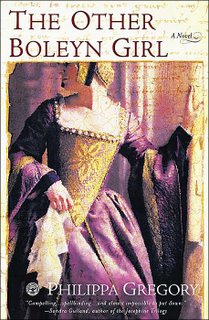 written by Philippa Gregory
written by Philippa Gregory
I am normally not one to pick up a nearly-700-page book. My mother-in-law, however (who left this book here for me when she visited at Christmastime), assured me it would be a very quick read. How true! It took me about a week, start to finish, and it was certainly a captivating story.
Billed as historical fiction, the novel introduces the lesser-known Boleyn sister, Mary, and uses her voice to tell a tale of love, deceit, politics, and power struggles as it follows the Boleyn family's attempt to gain a foothold in the court of King Henry VIII. Stopping at nothing to win the King's favor, Mary's uncle, upon noticing Henry's interest in Mary, arranges for 14-year-old Mary to become Henry's mistress. (This despite the fact that two years prior Mary had been given in an arranged marriage to another man of the court, and Henry had been wed to Queen Katherine for many years.) After a few years of "bedding the King," Mary gets eclipsed by her sister Anne, a much more cunning and manipulative sort with greater worldly beauty and magnetism than the dignified but humble Mary.
What begins as Anne's attempt to elevate her family's station in the royal pecking order evolves into a more self-centered plot: she ultimately ousts the virtuous Queen Katherine — poisoning and blackmailing a few courtiers and royal counselors along the way — and becomes queen herself by marrying Henry. To her own chagrin, though, she is unable to produce what Henry ultimately wants from her: a male heir. And we all know what happens to her in the end.
Really cool elements:
- This book helped me understand why Britons are so taken with the drama and intrigue wrapped up in the royal family. It's kind of like the morbid fascination our country has (or had) with the wiles of the Kennedy family, only on a much grander scale. It's like politics as entertainment.
- I love the literary technique of re-telling a famous story through the perspective of a not-so-famous character...
- ...and what an an appealing character Gregory spins up in Mary! She's a spirited but helpless pawn, caught in perpetual competition with an evil sister and victimized by a male-centric social system. And though she's a privileged and refined member of nobility, eventually she chooses to marry for love (instead of class) once she decides she can make a break from the corrupt goings-on in the royal court. She loves her children fiercely, she serves and supports her family tirelessly, she accepts her lot in life with dignity and grace. You can't help but pull for her as you read.
- Though the story doesn't exactly match up flawlessly with history, the flavor you get for a life in the day of the Tudor dynasty is, I am told, pretty accurate. It's very eye-opening, this glimpse into royal culture. It sheds light on the moral and spiritual tumult that can result when a society pays blind devotion to a very fallible human being. It's a good lesson even for our culture — though our society no longer idolizes a king, as individuals we are sometimes tempted to ascribe undue power and influence to other fallible humans, like presidents, pastors, bosses, spouses, parents, teachers, whoever.
Not-so-cool elements:
- Don't make the mistake of thinking this book is a pure portrayal of real history. Spend twenty minutes Googling "Mary Boleyn," "Henry VIII," and "Anne Boleyn" and you'll find more than a handful of discrepancies between historians' beliefs and Gregory's novel. I realize that "historical fiction" by definition includes fabrications of real characters' feelings, conversations, etc. And I do know that some historical records are patchy enough that authors must exercise artistic license to fill in the gaps. But many of the details in Gregory's story contradict verifiable facts. For example, most historians believe Mary was at least 16 or 18 before being foisted upon King Henry by her family; Gregory's version puts her at barely 14. Also, history shows that Mary had no contact with her sister Anne during the final few years of Anne's life; Gregory's story has their lives tightly intertwined all the way up to the time of Anne's public execution. Even more interesting is what Gregory chooses to omit from her story: before Mary ever became bedfellows with Henry, she was mistress to the King of France! I will admit, though, that the incongruity between the book and reality doesn't really both me that much, because ultimately books like these give me an appetite to dig and research and discover truth — and that can only be a good thing.
- Gregory's story vehemently villanizes Anne Boleyn as a power-hungry monster with absolutely no moral boundaries, especially when it came to advancing her own position. Since I knew next to nothing about English history at the time I picked up this book, at first I assumed this portrayal was accurate. Only after reading some background information on the Boleyns did I find that Anne, even though she wasn't exactly a popular favorite among the English people, probably was wrongly accused of the adultery charge that led to her beheading. In fact, she is almost universally believed to have been a deeply religious person with very clear moral convictions. The same is true of her brother George, whose role in Gregory's novel wasn't exactly savory either.
- This is petty, but some of the sentence structures in this novel are horrid. Maybe it's just a cultural thing (the author is English) or maybe it's because she is emulating patterns typical in English writings from the 1500s. In any case, sentence fragments abound. For example: "We sat long over dinner, this court had become gluttons." What harm would there be in using a semicolon instead of a period in that sentence?




No comments:
Post a Comment